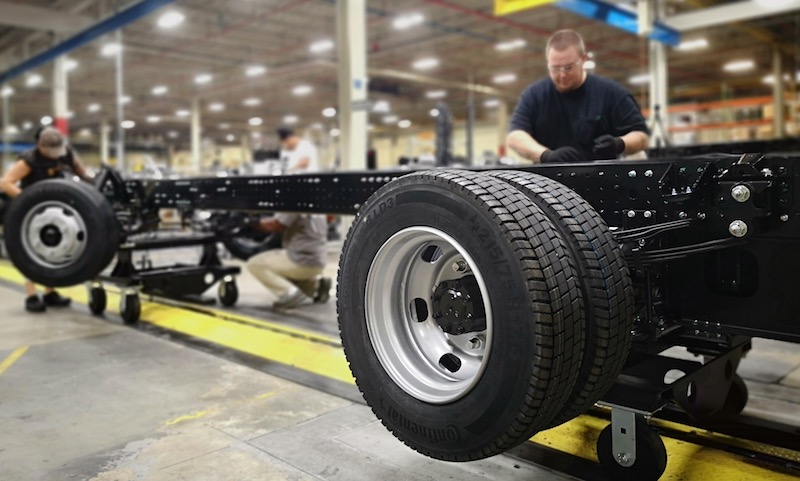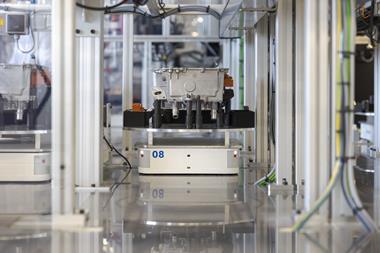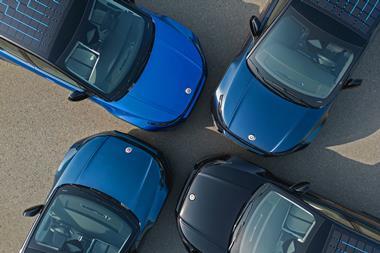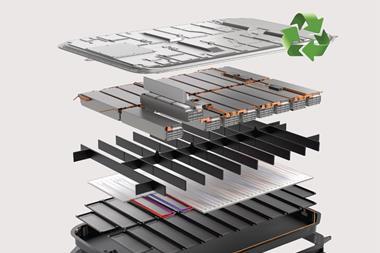The Freightliner Custom Chassis plant in Gaffney, South Carolina, houses a diverse assembly mix, and has recently taken on a new project
 Gaffney is a small town sitting off the beaten track. It was previously described as ‘the peach capital’ of South Carolina, with the local economy dependant on orchards that would produce the fruit. There is little to draw visitors to the area today, apart from the Peachoid – a giant novelty water tower situated on the I-85.
Gaffney is a small town sitting off the beaten track. It was previously described as ‘the peach capital’ of South Carolina, with the local economy dependant on orchards that would produce the fruit. There is little to draw visitors to the area today, apart from the Peachoid – a giant novelty water tower situated on the I-85.
But Gaffney is also home to Freightliner Custom Chassis Corporation (FCCC), which describes itself as a ‘leading manufacturer of premium vehicle chassis’ under parent-company Daimler. From its factory here, FCCC makes a variety of walk-in vans, Thomas Built school buses, motorhomes, and medium-duty trucks.
“So much has changed over the past 20 years in terms of product and setup,” Bryan Henke, manager of product marketing at FCCC told AMS. “When I came to work here in 1997, the facility was just getting into the school bus business, as well as motorhomes and walk-in vans.”
Henke was part of the original group of experts that built the FS-65 – the iconic yellow bus that still rolls along US highways today. “Now, we build medium-duty walk-in vans for the likes of FedEx and UPS, the C2 Thomas Built school bus, and we’re the number one producer of diesel RV chassis in the country,” he continues. “We are one of the main suppliers of medium-duty commercial buses, and have just recently started a new project with Mitsubishi Fuso.”
For Japan
The Mitsubishi Fuso venture includes the assembly of FE Series medium-duty trucks at the Gaffney plant using complete knockdown (CKD) kits. This area of the factory was previously used to assemble the Sprinter, which is now made at the Mercedes-Benz Vans site in Charleston, three and a half hours’ drive south of Gaffney.
“The idea was to bring the Fuso product into the states with a gasoline Allison powertrain, so that the company can compete against the Isuzu’s of the world,” Henke explained. “It made sense for us to take on the project as we have a firm grasp of gasoline engines and Allison transmissions with our walk-in vans.”
The cabs and chassis arrive from Portugal, while loose parts come from Japan and other facilities in North America. Around seven trucks per day travel down the line, though Henke said the project is in a “ramp-up phase.”
Steve Brooks, head of production at FCCC, was part of the team that liaised with Mitsubishi employees in Japan and Portugal in order to start making the trucks at Gaffney. “We had to work closely with the product design and development guys from Mitsubishi Fuso to ensure that we could assemble the truck here in our facility,” he recalled. “We’ve never done anything like that before, so it was a great experience. By working with the design guys, we were able to identify ways of streamlining assembly and production processes before we even started the project.”
Brooks was keen to emphasise that the project is being used as a test bed for assembly processes that could later be implemented on the other lines at the plant. “One of the assembly techniques we want to take from the Fuso line and implement on our other lines is the way we do mistake-proofing,” he noted. “It’s basically a way of ensuring that each component, down to the smallest bolt and nut, are put on the truck. It’s a technique used in passenger car production, and we will benefit from using it on our other lines too.”
People power
As well as the Mitsubishi Fuso FE Series, FCCC is also witnessing rising demand for other products. “We are churning out more commercial cabs now,” Henke revealed. “It started when we launched the commercial bus, and then we started making the SCG dedicated propane commercial truck as well as the S2 RV.”
The cabs come from the Mount Holly Truck Manufacturing plant, about an hour away from Gaffney, in their raw form. They are then fitted with a large variety of different trims depending on customer needs. Flexibility of the lines is crucial to allow for this customisation – a theme is was also evident at the Daimler Trucks North America (DTNA) plant in Cleveland.
This has meant that most assembly processes at Gaffney remain manual. “Where we can standardise and automate, we will,” Henke clarified. “But the scope for it is pretty small just because we are making so many different types of vehicle and so many different variants. A robot couldn’t replace a team member because of the sheer level of customisation and complexity of the products.”
For example, a frame found on one truck will have a certain number of holes for fixtures, while the frame for the next truck will likely have a different number of holes. “Unless we are building 1,000 identical trucks a month, then automating certain processes just doesn’t make sense,” Henke continued. “So we have to look elsewhere to get our efficiencies, and that is often in our people power.”
Production volumes at the plant have doubled in the last five years, yet FCCC continues to run just one shift. Several changes have been made to the layout in order to achieve this, such as the widening of the isles running alongside the production lines by three feet. This, Brooks commented, ensures that employees have better access to the conveyors. Although seemingly simple, the widening of isles was a major project, and one that has had a big impact on the efficiency of employees.
Shop floor workers also came up with a new design for the layout of one line. “By using this design, we were able to go from 24 jobs per hour on line three, which is what it was initially designed to do, to 33. We thought we would have to start a second shift, but we were able to hit the target with the same number of employees and also in the same footprint.”
Further improvement to the layout could soon be on the cards at Gaffney, Brooks revealed. This is due to the fact that less materials are now needed line-side as DTNA recently completed building a new logistics centre. The 200,000 sq.ft (18,580 sq.m) facility is the result of a $22.7m investment, and according to Henke, has already allowed the plant to become “more efficient and productive.”
One of a kind
Although he was eager to emphasise the importance of people power, Henke admitted there are more automated guided vehicles (AGVs) and robots now used at the factory. “We have no forklifts on the shop floor, which is unique in DTNA,” he observed. “Everything is pulled by the AGVs.”
There are also some unique processes and technologies used at the Gaffney plant. Henke pointed out a piece of equipment called a Lagonda. “A lot of our competitors don’t use it,” he said. “It’s a hydraulic squaring system with pins that make a witness mark, so everyone knows it has been used. If the chassis has any bow, it won’t drive properly, and the Lagonda allows us to ensure that it is straight. A lot of companies will try to identify this type of problem in pictures, but the Lagonda is calibrated so we can be highly accurate.”
Another unique use of technology at the plant is the IT management system that was created internally. This collates data from the numerous programmable logic controllers (PLCs) that are dotted about the factory, allowing Brooks and Henke to access information in real-time.
“Anything I want to see, I can access it on here, be it information from the assembly lines, from the quality gates or from the engineering people,” Brooks said. “And it is all in real time, so if I’m out of town, in Japan with Mitsubishi, for example, I can pull this up and I will know exactly what is going on at the plant.”
The system is primarily used to prevent production stoppages. One common threat is part shortages, but this can be easily monitored. “I can see exactly what we are short on, and when those parts are coming in,” Brooks stated. “I can also transmit messages to everyone in the plant or each of the teams individually, so it makes the people management side a lot easier too.”
As it was made in-house, the system is continuously evolving and becoming more detailed. A primary theme in vehicle factories all over the world is the adoption of digital tools, such as tablets and wearables, as well as the increasing proliferation of robots. Asked if the adoption of more digital systems in production would cause issues for the system, Brooks replied: “I think the opposite is true. The more important data that we can feed into this system, the better. But we have to identify what data is important to us first. We can’t overload it with useless information.”
Fairview and the Tulip
DTNA’s Gastonia Components and Logistics facility is located 30 minutes away from Gaffney along I-85, past the town’s iconic Peachoid. It provides stamping, metal fabrication and sub-assembly of cab and chassis parts.
“It’s basically a big machine shop,” Robert Gales, production manager at Gastonia Components and Logistics told AMS. “We have about 10,000 active part numbers that we make in a given year, 7,000 of which we make every month. That gives you some perspective of the variability. From a volume standpoint, we are shipping about 1m parts a week. Yesterday, for example, we shipped 225,061 parts.”
All of these parts will be used exclusively on Daimler Trucks vehicles. They are shipped to plants across North America and Mexico, as well as to other component distribution centres in the countries.
The site consists of two buildings, one of which – named Fairview – is primarily used for logistics. “We do some assembly here, such as clench nuts, active treatment systems and rear cross members for the back of the chassis,” Gales said. The vast majority of production and assembly is carried out at the other building, known as Tulip. This houses 29 coal-fed stamping presses that range between 100 and 800 tonnes; ten flat-bed two-dimensional lasers; and a machine shop. Among the latest additions to the facility are two new stamping presses, as well as a new e-coating system that started operating in February 2018.
“Where we had two systems prior, we’ve now just got the one, which has the capability to do everything the others did before and more. We’re just seeing more growth and higher demand, so we need to make more parts. Systems like these are integral to doing that,” Gales confirmed. Another example of a system that has increased efficiency at Gastonia is the transfer press. “This can do a lot of things at one time,” he said. “It uses a dye to blank pierce and form. It has arms that will go in after the press strokes, lift the part out, and move it to the next station.”
This has allowed the team at Gastonia to make significant gains in terms of efficiency. “We have a couple of jobs that we use in-dye clench nuts and studs. Traditionally we would make the part on the press line with a bunch of holes in it, before it would be taken to another area to put the studs in and nuts on. We’ve got dyes now that do all of that in one go, which drastically reduces the amount of operations that we need to do.”
Gales is confident that Daimler Trucks boasts considerable benefits over its competitors by carrying out press stamping, machining and various other production processes at one large facility in the US. “The primary reason we do this is capital,” he confirms. “We don’t have to have stamping presses at every single plant in the country. It doesn’t make sense to us. So we do it all in one location and then ship the parts. It means that we have a big task in terms of logistics, but at the end of the day, the savings we make on capital are well worth it.”
































